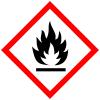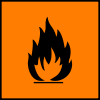Flammable substances
When flammable or flammable substances and are preparations if they have a low flash point have.
Whether a substance or a preparation is classified as flammable or flammable also depends on the applicable legal regulation. In the EU , substances and preparations or mixtures are classified in accordance with the Globally Harmonized System for Classification and Labeling of Chemicals (GHS for short), which is implemented by Regulation (EC) No. 1272/2008 (CLP Regulation) from January 20th Was introduced gradually in 2009. The GHS replaced the European Directive 67/548 / EEC , which was valid from June 27, 1967 and was repealed on June 1, 2015 by the CLP regulation; Substances and mixtures that were classified and labeled according to the old rules were only allowed to be placed on the market until December 1, 2012, and until June 1, 2017. In Germany, the relevant guidelines and ordinances are implemented through the currently applicable Hazardous Substances Ordinance.
Classification according to GHS
Assigned to the three classic states of aggregation, the danger is classified into categories, which are numbered consecutively. In GHS we no longer speak of inflammatory, but inflammable cash fabrics.
Flammable gases
Gases or their mixtures, which have an explosive range in air at 20 degrees and a standard pressure of 101.3 kPa, are flammable gases, while aerosols and chemically unstable gases have their own critics. Based on the lower (LEL) and upper explosion limit (UEL), they are divided into:
- Category 1: LEL ≤ 13% or (UEG - LEL) ≥ 12% (Flam. Gas 1; to be identified with pictogram, signal word "Danger" and hazard warning H220 Extremely flammable gas )
- Category 2: All other gases with an explosion range (LEL <OEG) (Flam. Gas 2)
Flammable liquids
They are divided into three categories based on their flash point and boiling point :
- Category 1: Flash point <23 ° C and boiling point ≤ 35 ° C (Flam. Liq. 1)
- Category 2: Flash point <23 ° C and boiling point> 35 ° C (Flam. Liq. 2)
- Category 3: Flash point ≥ 23 ° C and ≤ 60 ° C (Flam. Liq. 3)
Category 4 with a flash point> 60 ° C and ≤ 93 ° C (Flam. Liq. 4) from the UN-GHS was not adopted for the EU by the CLP regulation . However, it stipulates that, for its purposes, gas oils, diesel and light heating oils with a flash point between 55 and 75 ° Celsius are classified as category 3, although it expressly only defined liquids with a flash point of 60 ° Celsius or less as flammable liquids .
Flammable solids
Solids are defined as flammable if they cause or promote fire through friction or are easily combustible; Powdery, granular or pasty substances or mixtures are easily combustible because they can be ignited by brief contact with an ignition source such as a burning match, and the flames then spread rapidly. Flammable solids are divided into two categories by means of test N.1 according to the UN test manual on the basis of the burning rate and the burning behavior:
- Category 1 (Flam. Sol. 1):
- Metal powder that burns off in up to 5 minutes, or
- other solids and mixtures that burn off in less than 45 seconds or at a speed of more than 2.2 mm / s without stopping a humidified zone
- Category 2 (Flam. Sol. 2):
- Metal powder that burns off in more than 5 and up to 10 minutes,
- other solids or mixtures thereof that burn off quickly in less than 45 s or at more than 2.2 mm / s, which, however, holds up a humidified zone for at least 4 minutes.
Directive 67/548 / EEC
Classification and labeling
The repealed Directive difference between flammable, highly flammable or highly flammable . As flammable (initially combustible thereafter substances and preparations which, as a liquid substances and preparations having a flash point 21-55 were) ° C have. Hazardous substances were labeled with the R-phrase R10 - Flammable . Substances with a flash point below 21 ° C and extremely flammable with a flash point <0 ° C and a boiling point ≤ 35 ° C were classified as highly flammable. Highly flammable substances have been marked with R11 - Highly flammable , a hazard symbol with the black flame on an orange background and the letter F , extremely flammable substances with R12 - Extremely flammable , the same hazard symbol and the identifier F + .
safety instructions
When sold to end users, the S-phrases S2 - Keep out of the reach of children and, if necessary, S43 - To extinguish… were also used. (If water increases the risk, the following could be added: “Do not use water”)). It must be clearly stated what is to be used for extinguishing (water, sand, carbon dioxide) or must not be used: For many flammable substances, for example, an attempt to extinguish with water increases the risk if the substance floats on the extinguishing water due to its low density, spreads there and continues to burn over a large area or when the substance reacts with water (for example halogen alkanes ) and releases energy and / or toxic products. S33 (“Take measures against electrostatic charging”) could also be necessary to indicate the risk of ignition sparks.
Comparison of the classification according to GHS and Directive 67/548 / EEC
The following table compares the classification according to GHS and Directive 67/548 / EEC:
| aggregate state |
GHS | Directive 67/548 / EEC | |||
|---|---|---|---|---|---|
| H-phrase | annotation | pictogram | R phrase | symbol | |
| firmly | H228 | Flam. Sol. 1 |
GHS02 |
R11 (F) |
|
| H228 | Flam. Sol. 2 | ||||
| liquid | H224 | Flam. Liq. 1 | R10 (no symbol) R11 (F) R12 (F +) |
||
| H225 | Flam. Liq. 2 | R10 (no symbol) R11 (F) |
|||
| H226 | Flam. Liq. 3 | R10 | |||
| liquid | H242 | Self-react. CD | R12 (F +) |
|
|
| H242 | Self-react. EF | ||||
| - | Self-react. G | ||||
| gas | H220 | Flam. Gas 1 | |||
| H221 | Flam. Gas 2 | no | |||
| solid / liquid | H260 | Water react. 1 |
GHS02 |
R15 (F) |
|
| H261 | Water react. 2 | ||||
| H261 | Water react. 3 | ||||
| firmly | H250 | Pyr. Liq. 1 | R17 (F) | ||
| liquid | H250 | Pyr. Sol. 1 | |||
Safety measures
Companies that handle large quantities of flammable substances must publicly display operating instructions for handling these substances and train their employees accordingly. Flammable waste may only be stored in the containers provided and, if possible, only in smaller quantities. Open flames in the area are to be avoided. The phenomenon of creeping vapors of many substances must also be taken into account.
Prohibition
Flammable substances of all categories (as well as self-igniting gases and liquids of category 1) may not be generally placed on the EU market in aerosol dispensers, provided they are intended for so-called entertainment and decorative purposes, e.g. for artificial snow or artificial cobwebs, joke excrements or indecent noises. Such packaging must be permanently and legibly marked with "For commercial users only". A violation of the prohibition of supply to or making available to the general public is a criminal offense in Germany even in the case of negligence or as an attempt.
literature
- Cordula Wilrich: GHS - Physical Hazards. In: baua.de. March 19, 2009, accessed January 10, 2016 .
- United Nations: Recommendations for the Movement of Dangerous Goods. (pdf) Manual of exams and criteria. Federal Institute for Materials Testing , 2015, pp. 1–501 , accessed on January 11, 2016 .
See also
- Category: Flammable substance (list of substances classified as extremely flammable or highly flammable according to GHS )
- dangerous goods
- Ordinance on Flammable Liquids
Individual evidence
- ↑ Art. 61 para. 4 CLP regulation
- ↑ Appendix I (Part 2: Physical Hazards) No. 2.2. of Regulation (EC) No. 1272/2008
- ↑ Appendix I, no. 2.6 of Regulation (EC) No. 1272/2008, definition of terms under No. 2.6.1
- ↑ Appendix I, no. 2.7 CLP Regulation
- ↑ Cordula Wilrich: When it pops and burns - classification of physical hazards. In: reach-clp-biozid-helpdesk.de. Retrieved January 10, 2016 .
- ↑ Reach Compliance: Globally Harmonized System (GHS) - ANNEX VII: Translation table from classification under Directive 67/548 / EEC to classification under this Regulation. In: reach-compliance.eu. Archived from the original on March 4, 2016 ; accessed on January 10, 2016 .
- ↑ BAuA : The Globally Harmonized System (GHS) in the EU - Orientation aid - Physical hazards, environmental hazards. (pdf). CLP Regulation Annex VII Table for converting a classification according to Directive 67/548 / EEC into a classification according to this regulation.
- ↑ Art. 67 Annex XVII no. 40 column 2 no. 1 and 4 Regulation (EC) No. 1907/2006 with a list of other such examples; for exception and identification no. 1 and 2
- ↑ § 5 no. 23 Chemical Sanctions Ordinance with Section 27 Chemicals Act; Violation of the labeling regulation subject to a fine via § 6 Paragraph 2 No. 9 ChemSanktionsV

